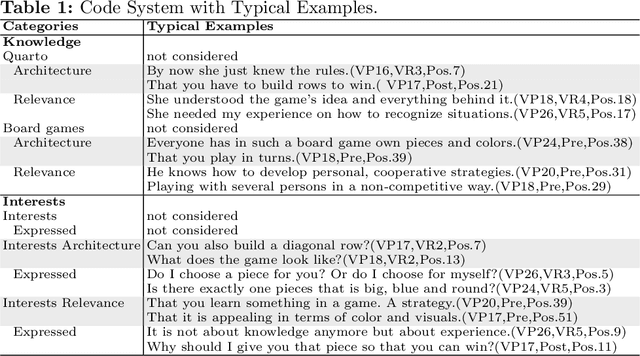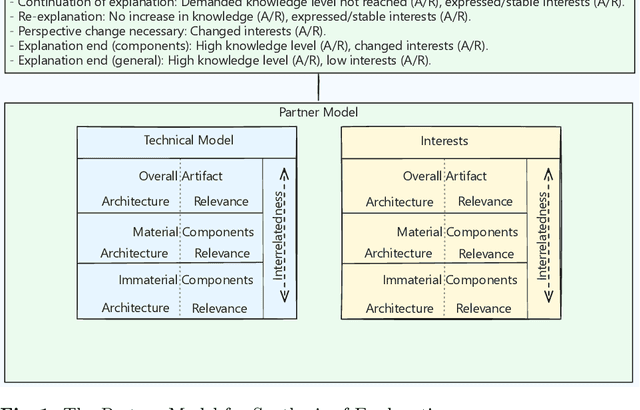Carsten Schulte
Explainers' Mental Representations of Explainees' Needs in Everyday Explanations
Nov 13, 2024



Abstract:In explanations, explainers have mental representations of explainees' developing knowledge and shifting interests regarding the explanandum. These mental representations are dynamic in nature and develop over time, thereby enabling explainers to react to explainees' needs by adapting and customizing the explanation. XAI should be able to react to explainees' needs in a similar manner. Therefore, a component that incorporates aspects of explainers' mental representations of explainees is required. In this study, we took first steps by investigating explainers' mental representations in everyday explanations of technological artifacts. According to the dual nature theory, technological artifacts require explanations with two distinct perspectives, namely observable and measurable features addressing "Architecture" or interpretable aspects addressing "Relevance". We conducted extended semi structured pre-, post- and video recall-interviews with explainers (N=9) in the context of an explanation. The transcribed interviews were analyzed utilizing qualitative content analysis. The explainers' answers regarding the explainees' knowledge and interests with regard to the technological artifact emphasized the vagueness of early assumptions of explainers toward strong beliefs in the course of explanations. The assumed knowledge of explainees in the beginning is centered around Architecture and develops toward knowledge with regard to both Architecture and Relevance. In contrast, explainers assumed higher interests in Relevance in the beginning to interests regarding both Architecture and Relevance in the further course of explanations. Further, explainers often finished the explanation despite their perception that explainees still had gaps in knowledge. These findings are transferred into practical implications relevant for user models for adaptive explainable systems.
What you need to know about a learning robot: Identifying the enabling architecture of complex systems
Nov 24, 2023Abstract:Nowadays, we are dealing more and more with robots and AI in everyday life. However, their behavior is not always apparent to most lay users, especially in error situations. As a result, there can be misconceptions about the behavior of the technologies in use. This, in turn, can lead to misuse and rejection by users. Explanation, for example, through transparency, can address these misconceptions. However, it would be confusing and overwhelming for users if the entire software or hardware was explained. Therefore, this paper looks at the 'enabling' architecture. It describes those aspects of a robotic system that might need to be explained to enable someone to use the technology effectively. Furthermore, this paper is concerned with the 'explanandum', which is the corresponding misunderstanding or missing concepts of the enabling architecture that needs to be clarified. We have thus developed and present an approach for determining this 'enabling' architecture and the resulting 'explanandum' of complex technologies.
Adding Why to What? Analyses of an Everyday Explanation
Aug 08, 2023Abstract:In XAI it is important to consider that, in contrast to explanations for professional audiences, one cannot assume common expertise when explaining for laypeople. But such explanations between humans vary greatly, making it difficult to research commonalities across explanations. We used the dual nature theory, a techno-philosophical approach, to cope with these challenges. According to it, one can explain, for example, an XAI's decision by addressing its dual nature: by focusing on the Architecture (e.g., the logic of its algorithms) or the Relevance (e.g., the severity of a decision, the implications of a recommendation). We investigated 20 game explanations using the theory as an analytical framework. We elaborate how we used the theory to quickly structure and compare explanations of technological artifacts. We supplemented results from analyzing the explanation contents with results from a video recall to explore how explainers justified their explanation. We found that explainers were focusing on the physical aspects of the game first (Architecture) and only later on aspects of the Relevance. Reasoning in the video recalls indicated that EX regarded the focus on the Architecture as important for structuring the explanation initially by explaining the basic components before focusing on more complex, intangible aspects. Shifting between addressing the two sides was justified by explanation goals, emerging misunderstandings, and the knowledge needs of the explainee. We discovered several commonalities that inspire future research questions which, if further generalizable, provide first ideas for the construction of synthetic explanations.
 Add to Chrome
Add to Chrome Add to Firefox
Add to Firefox Add to Edge
Add to Edge